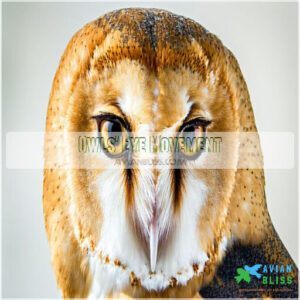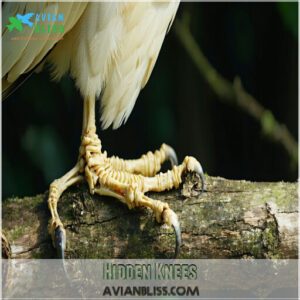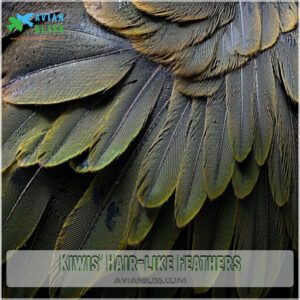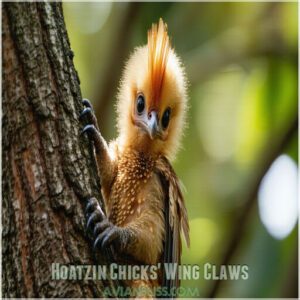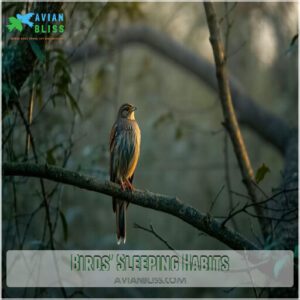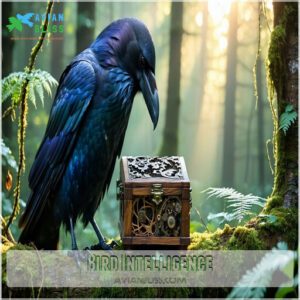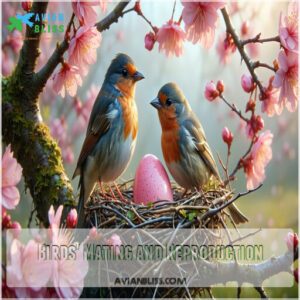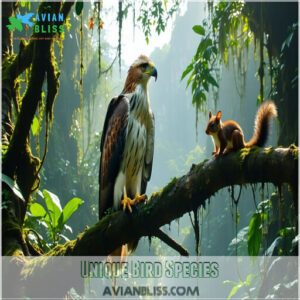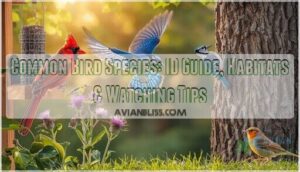This site is supported by our readers. We may earn a commission, at no cost to you, if you purchase through links.
 You’re about to discover some amazing unusual bird facts. Birds have unique features, like the sword-billed hummingbird’s long bill, owls’ 270-degree head rotation, and efficient lungs.
You’re about to discover some amazing unusual bird facts. Birds have unique features, like the sword-billed hummingbird’s long bill, owls’ 270-degree head rotation, and efficient lungs.
They also have hidden knees, and their urine crystallizes to conserve water. These adaptations make birds fascinating creatures.
You’ll learn more about their strange features, intelligent behaviors, and remarkable abilities, making you appreciate these animals even more. Get ready to explore the wonderful world of unusual bird facts, and find out what other surprising traits they have.
Table Of Contents
- Key Takeaways
- Unique Bird Anatomy
- Strange Bird Features
- Birds’ Sleeping Habits
- Bird Intelligence
- Birds’ Mating and Reproduction
- Unusual Bird Behaviors
- Bird Conservation Status
- Birds’ Roles in Human Civilization
- Unique Bird Species
- Bird Evolution and History
- Frequently Asked Questions (FAQs)
- Which bird has a longer bill than its body?
- What are some interesting facts about birds?
- What do you know about 15 amazing bird species?
- What is the weirdest bird of all?
- What is the most common bird in the world?
- What birds have bizarre behaviors?
- What are some odd facts about birds?
- What is the most unusual bird?
- What are the unique features of birds?
- What are the unique abilities of birds?
- Conclusion
Key Takeaways
- You’ll discover that birds have some amazing adaptations, like the Sword-billed Hummingbird’s long bill and owls’ ability to rotate their heads up to 270 degrees, which help them survive and thrive in their environments.
- You’ll learn that birds have unique physical characteristics, such as hollow bones, specialized beaks, and efficient lungs, which set them apart from other creatures and enable them to fly, dive, and thrive in various habitats.
- You’ll find that birds exhibit some pretty bizarre behaviors, like sleeping with one eye open, using unihemispheric sleep, and engaging in unique mating rituals, which showcase their intelligence and remarkable abilities.
- You’ll appreciate that birds are incredibly diverse, with over 10,000 different species, each with its own unique features, abilities, and characteristics, making them fascinating creatures that are worth learning about and protecting.
Unique Bird Anatomy
You’re about to explore some amazing bird anatomy facts that will surprise you.
As you learn about unique bird features, like the Sword-billed Hummingbird’s long bill and owls’ eye movement, you’ll discover how these special traits help birds survive and thrive in their environments.
Sword-billed Hummingbird’s Long Bill
You’re looking at the Sword-billed Hummingbird, with a bill longer than its body.
You can find sword-billed hummingbird beak products.
- It has a unique bill structure
- Feeding habits are specialized
- Beak functions are impressive
- Hummingbird adaptations are remarkable
- Long beaks are a key feature, making this bird’s feeding habits truly one-of-a-kind.
Owls’ Eye Movement
You can’t move your eyes like owls.
They rotate their heads up to 270 degrees for night vision, using binocular sight.
| Owl Vision | Eye Rotation |
|---|---|
| Sharp | 270 degrees |
| Binocular | Night Vision |
| Wide | Head Movement |
Owls have eagle eyesight, great bird anatomy.
Birds’ Urine Crystallization
You’ll find bird urine is white, pasty, and contains uric acid.
Here are three key facts:
- Conserves water
- Maintains electrolyte balance
- Unique crystallization process, aiding kidney function and waste management in bird anatomy and physiology.
These facts highlight how bird urine’s composition and the unique crystallization process play a crucial role in the bird’s overall health and efficiency of its bodily functions.
Efficient Lungs
You’ll be amazed by bird lungs, which have air sacs for efficient gas exchange, allowing higher oxygen efficiency than mammalian lungs.
Making their breathing rate and lung capacity remarkably effective for flight, a key aspect of bird biology and physiology, showcasing unique bird characteristics, with air sacs for efficient gas exchange, is a critical factor.
This unique system allows for higher oxygen efficiency than mammalian lungs, contributing to the remarkable adaptability of birds in various environments.
Hidden Knees
You’ll notice birds’ legs seem different.
Their knees are hidden under feathers, what you see is their ankle. This unique leg structure aids balance and agility.
Here are key points:
- Knee Structure
- Leg Anatomy
- Joint Movement
- Bird Posture
- Skeletal System, which is crucial for their agility.
Strange Bird Features
You’re about to discover some amazing bird features that will surprise you.
As you read on, you’ll learn about ostriches’ large eyes, kiwis’ hair-like feathers, and other strange features that make birds unique creatures.
Ostriches’ Large Eyes
You’ll discover ostriches have incredibly large eyes, bigger than their brains.
Their eye structure allows for exceptional vision range, aiding in spotting predators.
With eagle eyesight, ostriches boast unusual bird facts, showcasing their impressive bird vision, specifically ostrich sight, and remarkable eye size, a unique feature among birds.
Kiwis’ Hair-like Feathers
You’ll love kiwis’ hair-like feathers.
They have:
- Unique feather structure
- Kiwi plumage for camouflage
- Specialized feather evolution
- Adaptation for flight mechanics
They are a great example of unusual bird facts and unique characteristics of birds, like the kiwi bird, with its distinct bird feathers, and soft, hair-like texture.
Hoatzin Chicks’ Wing Claws
You’re exploring strange bird features.
Now, let’s look at Hoatzin chicks’ wing claws.
| Feature | Function |
|---|---|
| Wing Claws | Climbing |
| Sharp Tips | Defense |
| Muscle Control | Grip |
These claws help Hoatzin chicks climb trees, and are a unique adaptive feature of the Opisthocomus hoazin species, with a special forelimb structure, and are an example of unique bird characteristics, and are used for tree climbing, and are a key part of chick development.
Woodpeckers’ Long Tongues
You’ll find woodpeckers have super long tongues, up to 4 inches, which wrap around their skulls.
This helps them grab insects from deep in tree bark, a key part of their diet, using their strong beaks and unique pecking mechanics, showing off their amazing tongue structure and adaptation.
Birds’ Sleeping Habits
You’re about to learn some amazing facts about birds’ sleeping habits, and they’re really interesting.
Birds sleep in short periods, and they can even sleep with one eye open, which helps them stay safe from predators, and they also have a special toe grip mechanism that keeps them from falling off branches, utilizing a unique mechanism.
Toe Grip Mechanism
You’ll notice birds have a special toe grip mechanism, ensuring sleep safety on branches.
Their toes lock automatically, thanks to specialized tendons, providing perch control with their claw function, a unique aspect of bird toes and fingers.
This unique mechanism is related to bird physiology and anatomy, similar to a woodpecker’s tongue.
Sleeping With One Eye Open
You sleep with both eyes closed, but ducks can sleep with one eye open.
They use unihemispheric slow-wave sleep, keeping half their brain alert.
Here’s how:
- Rest while alert
- Half-brain sleep
- Bird vigilance
- One eyed rest
- Unique sleep patterns
Unique Sleeping Positions
You observe birds resting in various ways, like roosting, nesting, or hanging upside-down, showcasing unique sleeping positions, such as Perch Sleeping, and Resting Postures, including nocturnal rest, as part of their bird behavior.
You also learn about weird bird facts, like some species sleeping on one leg, while others prefer group sleepovers for safety.
Bird Intelligence
You’re about to discover some amazing facts about bird intelligence, and it’s going to change the way you think about these creatures.
As you learn about birds like ravens, cardinals, and flamingos, you’ll see that they’re capable of some pretty cool things, like mimicry, unique feeding habits, and problem-solving.
Ravens’ Mimicry
You’ll discover ravens’ impressive vocal learning and mimicry skills.
They can imitate human speech, animal sounds, and noises.
Here are some examples:
- Imitating wolves
- Mimicking foxes
- Reproducing human tunes
- Learning new sounds
- Adapting to environments.
This showcases their intelligence and bird vocalization abilities, making them a fascinating species to study, with unique bird characteristics and raven intelligence.
Cardinals’ Anting Behavior
You’ll find cardinals engaging in "anting", rubbing ants on feathers.
This behavior:
- Removes parasites
- Soothes skin
- Prepares feathers
- Provides a natural high from formic acid, a fun fact about unique bird behaviors, showcasing bird hygiene and ant interactions, a strange bird fact about feather maintenance and parasite control.
Birds also demonstrate surprising feats of intelligence, like tool use and complex communication, which is a fun fact about their social behavior, and they also exhibit unique bird behaviors.
Flamingos’ Unique Feeding Habits
You’ll see flamingos feeding upside-down, using their uniquely shaped beaks as filters.
Their diet consists of algae and small crustaceans, giving them a pink hue.
Flamingos’ feeding habits are social, foraging in groups, and their beak shape allows for efficient food sourcing, making them a fascinating bird species.
Birds’ Mating and Reproduction
You’re about to learn some amazing facts about birds’ mating and reproduction.
As you read on, you’ll discover interesting facts, like how some birds form long-term pairs, and how others lay incredibly large eggs relative to their body size.
Flamingos’ Lifetime Partners
You’ll be surprised that flamingos, with their flashy looks, are actually monogamous, forming lifetime mates through elaborate Mating Rituals and Flamingo Courtship.
They showcase unique bird traits and Pair Bonding, making them one of the few bird species with strong, monogamous relationships, also known as Lifetime Mates.
Ostriches’ Large Eggs
You’re learning about ostriches’ huge eggs, a key part of bird reproduction.
Here are some facts:
- Large eggs
- Strong shells
- Long incubation, showing unusual bird characteristics, like the ostrich, in Egg Formation and Ostrich Nesting.
Kiwis’ Large Eggs Relative to Body Size
You’ll discover kiwi birds have unusually large eggs, weighing up to a third of the mother’s weight, which is a remarkable body ratio, showcasing unique kiwi reproduction and egg formation characteristics, with large clutches, an interesting aspect of bird eggs and unusual bird characteristics.
These flightless birds’ conservation is paramount due to their declining population, and you can learn more about why they are called kiwis through this flightless birds’ conservation link.
Unusual Bird Behaviors
You’re about to discover some amazing bird behaviors that will surprise you.
As you read on, you’ll learn about unusual habits like hummingbirds flying backwards, fieldfares’ unique attacks, and ducks sleeping with one eye open.
Hummingbirds’ Backward Flight
You’ll love hummingbirds’ unique bird behaviour: they fly backward.
Their aerodynamic feathers, wing movement, and flight patterns overcome air resistance.
Here’s what’s amazing:
- Fast wing beats
- Special feather structure
- Agile flight
- Rubythroated Hummingbird’s cool moves, showcasing their aerodynamic abilities.
Fieldfares’ Unique Attack Method
You’re about to witness Fieldfare birds’ quirky defense tricks.
They use a unique attack method, employing defecation tactics to repel intruders.
This bird behavior showcases avian aggression, with Fieldfare Tactics involving aerial warfare and defense mechanisms.
Fieldfares’ attack strategies are a fun fact, highlighting strange bird behavior and unusual birds’ abilities to adapt and protect themselves, demonstrating Fieldfare Tactics.
Ducks’ One-Eyed Sleep
You observe ducks sleeping with one eye open.
They use unihemispheric sleep, where one brain hemisphere rests while the other stays awake.
- Constant vigilance against predators
- Built-in security system
- Unique resting habits, showing bird vigilance and interesting duck behavior, a strange bird fact about unique birds, demonstrating constant vigilance.
Bird Conservation Status
You’re about to learn some surprising facts about birds, and it starts with understanding their conservation status.
As you read on, you’ll discover how human activities affect bird populations, and what it means for the future of these amazing creatures.
Endangered Species
You’re helping endangered birds by learning about habitat loss, species extinction, and conservation efforts, supporting wildlife protection and biodiversity preservation for unique birds.
You’re also understanding the importance of bird conservation to prevent bird extinction.
Astonishingly, a chicken’s closest relative is the Tyrannosaurus Rex.
Human Impact on Bird Populations
You impact bird populations through habitat loss, climate change, and pollution.
Human activities like invasive species and hunting threaten birds.
Agricultural expansion, logging, and invasive species threaten global bird populations.
Bird conservation efforts address these challenges, protecting endangered species and habitats, while also considering climate change and bird strikes as significant concerns, and how ecotourism supports conservation.
Extinct Bird Species
The story of extinct birds reads like a lost chapter in Earth’s book.
From the clumsy Dodo Birds to the mighty elephant bird, these vanished creatures tell tales through their fossil records.
- The passenger pigeons once darkened American skies by the billions
- Ancient wings of Archaeopteryx bridge the gap between dinosaurs and modern birds
- Bird fossils reveal species we’ll never see again
- Extinct species, like the great auk, fell victim to human hunting
You’re part of their legacy now. Will you help protect what remains, and preserve the memory of these vanished creatures?
Birds’ Roles in Human Civilization
You’ll be amazed to learn that birds have shaped human civilization in ways you never imagined, from providing food and companionship to driving a billion-dollar birdwatching industry.
While chickens supply over 100 billion eggs yearly worldwide, other birds like eagles hold such cultural significance that some countries protect them with harsh jail sentences.
Domesticated Birds
While we protect wild birds, millions of pet birds brighten homes worldwide.
From clever parrots that mimic your words to racing pigeons that find their way home from miles away, domesticated birds showcase amazing abilities.
Bird training reveals their smarts – they’ll learn tricks, solve puzzles, and even dance to music.
Chicken keeping’s gained popularity too, with backyard flocks showing distinct personalities, proving that fowl behavior is anything but boring, and that these feathered friends are truly domesticated birds.
Birds as Food Sources
Birds have played an essential role in human food chains throughout history.
From traditional hunting practices to modern poultry farming, bird meat provides essential protein for millions.
You’ll find diverse approaches to bird consumption worldwide – some cultures sustainably harvest eggs from wild nests, while others focus on domesticated species.
Notably, bird physiology and diet directly influence meat quality; free-range birds often develop different muscle compositions than their farm-raised counterparts.
While egg consumption remains widespread, conservation efforts now guide many hunting practices, ensuring bird ecology stays balanced.
The history of bird domestication processes is complex and involves various factors, including selective breeding and adaptation to captivity.
Ecotourism and Birding
You can explore bird habitats through ecotourism and birdwatching.
Consider supporting birding ecotourism product vendors.
- Eco Tours support wildlife conservation
- Sustainable Travel promotes bird species preservation
- Bird conservation efforts aid bird identification guide development, helping you discover rare birds.
Unique Bird Species
You’re about to discover some amazing bird species that are truly one-of-a-kind.
As you explore unique bird species, like the Philippine Eagle, Kakapo, and Magnificent Frigatebird, you’ll learn fascinating facts about their habitats, behaviors, and characteristics, which will help you understand these amazing bird species.
Philippine Eagle
You’re learning about unique birds, like the Philippine Eagle, or Haring Ibon, a Philippine endemic species.
The following table provides information about different bird species:
| Species | Habitat | Conservation |
|---|---|---|
| Pithecophaga jefferyi | Forests | Endangered |
| Eagle | Mountains | Vulnerable |
| Bird | Trees | Least Concern |
| Haring Ibon | Philippines | Critically Endangered |
Kakapo
Meet the Kakapo, a flightless parrot with nocturnal habits.
As a rare species, its conservation status is precarious.
Birds exhibit unique physical characteristics, including specialized beaks and feathered bodies.
The Kakapo, or Strigops habroptilus, has unique characteristics, including a specialized diet, making it an unusual animal, and one of the rarest bird species, needing dedicated conservation efforts to survive.
Magnificent Frigatebird
You’ll love the Magnificent Frigatebird‘s inflated throat sac.
- It’s a sea bird with amazing flying techniques
- Frigatebird mating is unique
- They’ve a distinct diet
- Their bird migration patterns are fascinating
Rhinoceros Hornbill
You’re now looking at the Rhinoceros Hornbill, a bird with a distinctive casque on its beak, living in Southeast Asia’s rainforests.
This exotic bird species, Buceros rhinoceros, showcases unique bird behaviours, with a unique Hornbill Diet, and interesting Nesting Behavior.
Bird Evolution and History
You’re about to explore the fascinating history of birds, and it’s pretty cool that you get to learn about their evolution.
As you read on, you’ll discover that birds are actually living dinosaurs, and their history is filled with interesting facts.
Like how they originated from theropod dinosaurs around 160 million years ago, which is a pretty cool fact.
Birds as Living Dinosaurs
You’ll discover birds are direct descendants of feathered theropod dinosaurs, with fossil records showing Dino Feathers.
Revealing avian evolution from theropod links, and showcasing bird origins, is a fascinating example of avian evolution.
With birds being the last living dinosaurs.
Evolution of Modern Birds
You’re exploring bird evolution. Here are key points:
- Bird Origins
- Fossil Records
- Species Diversification
- Avian Adaptations
- Evolutionary History
birds evolved from feathered theropod dinosaurs, with fossil records showing avian adaptations over time, and species diversification leading to various bird species.
Ancient Bird Species
You’re face to face with ancient birds, like Archaeopteryx, a dinosaur-bird hybrid.
- Fossil records reveal ancient origins
- Bird fossils show dinosaur links
- Extinct species tell lost stories, shaping bird evolution and our understanding of the Mesozoic Era.
Frequently Asked Questions (FAQs)
Which bird has a longer bill than its body?
You’ll find the Sword-billed Hummingbird has a bill longer than its body, which is pretty cool, and helps it reach nectar deep within flowers easily, every time.
What are some interesting facts about birds?
You’ll learn birds have hollow bones, unique beaks, and amazing adaptations, like flamingos getting pink hue from diet, and ostriches having large eyes, bigger than their brains, pretty cool, right?
What do you know about 15 amazing bird species?
You’ll discover birds like penguins, ostriches, and hummingbirds, each with unique features, like the penguin’s flightless wings and ostrich’s powerful legs, showcasing amazing diversity.
What is the weirdest bird of all?
You’ll think the Hoatzin is weird, with its smelly, clawed chicks and unique digestive system, making it a one-of-a-kind bird species that’s pretty fascinating, actually.
What is the most common bird in the world?
What a hoot, you’re wondering what’s the most common bird? It’s the red-billed Quelea, with an estimated 5 billion breeding pairs, you’ll likely spot them in large flocks.
What birds have bizarre behaviors?
You’ll find birds like woodpeckers, flamingos, and penguins exhibiting bizarre behaviors, such as anting, sleeping with one eye open, and regurgitating pellets, showcasing their unique adaptations and survival strategies.
What are some odd facts about birds?
Can you imagine birds with weird traits? You’ll learn that ostriches have huge eyes, flamingos get pink from food, and penguins can’t fly, showcasing birds’ amazing, odd characteristics naturally.
What is the most unusual bird?
You’ll discover the Hoatzin, a bird with claws on its wings, a foul odor, and a unique digestive system, making it a fascinating, one-of-a-kind species.
What are the unique features of birds?
Like a master painter, you’ll notice birds‘ unique features, such as hollow bones, waterproof feathers, and specialized beaks, which set them apart from other creatures, making them fascinating to study.
What are the unique abilities of birds?
You’ll notice birds have unique abilities, such as echolocation, mimicry, and exceptional eyesight, allowing them to adapt and thrive in various environments.
Some species exhibiting remarkable intelligence and problem-solving skills.
Conclusion
You might think you know birds, but they’re full of surprises.
Discovering these unusual bird facts is fascinating, and you’ll appreciate their unique features. From hummingbirds to owls, learning about their strange behaviors and adaptations is interesting.
Now, you know more unusual bird facts, and you can share them with others, exploring the wonderful world of birds and their amazing abilities.
- https://www.weareteachers.com/bird-facts/
- https://www.mentalfloss.com/article/78996/15-amazing-facts-about-15-birds
- https://www.ducks.ca/stories/wildlife/surprising-facts-about-backyard-birds/
- https://neotropical.birds.cornell.edu/Species-Account/nb/species/hoatzi1/overview
- https://www.pinterest.com/pin/736338607803097354/


